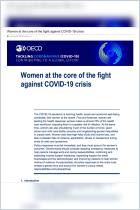The International Labour Organization shines a spotlight on the plight of care workers during the COVID-19 pandemic in an informative brief. The paper highlights the disproportionate impact care workers have suffered during the pandemic crisis, calling on governments, employers and sectoral organizations to support decent working conditions for these essential workers. Issued in October 2020, the brief draws attention to longstanding challenges in the care sector and looks toward creating resilience and equity in the sector post-pandemic.
Care workers’ employment conditions have placed them at high risk of contracting – and passing on – COVID-19.
Care workers include people who work in a variety of settings, such as nursing homes, clinical facilities, communities and private homes, to provide personal care and basic health care as well as help with mobility and activities of daily living. During the COVID-19 pandemic, care workers have likely experienced high rates of infection and death, although little data is available. Care workers often work long hours for low – or no – pay and lack access to benefits such as paid sick leave and social insurance in case of loss of income. Many cannot take advantage of social health protection measures such as health care or, during the COVID-19 pandemic, financial compensation provided to people who become infected.
As a result, care workers often continue to work even while sick. The pandemic has placed additional burdens on them, including working longer hours and navigating conflicts with patients who don’t understand, or have difficulty following, hygiene guidelines. In addition, many care workers visit multiple facilities or private homes each day, increasing...
An agency of the United Nations, the International Labour Organization brings together governments, employers and workers of 187 member states to promote decent work for all women and men.




















Comment on this summary